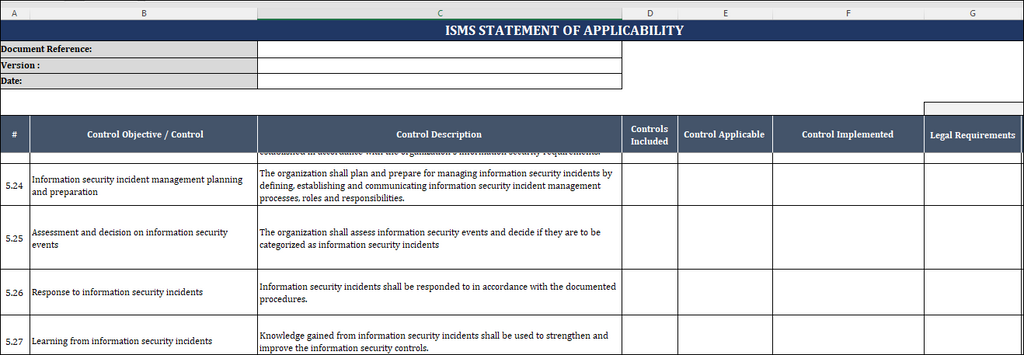The Statement of Applicability (SOA) | Statement of Applicability Excel Template
A Statement of Applicability is a document that details whether an entity must abide by the Privacy Act. This law governs how the government gathers, uses, and discloses personal information. The standards used to decide if an organization needs to comply are outlined in the SOA Excel Template. It also contains details on the requirements for handling personal data, including how to gather it and how long to keep it.
What Makes the Statement of Applicability Valuable?
The Statement of Applicability is necessary for specific environmental licenses. The land disturbance activities covered by this permit, their length, and the requirements for site restoration following the completion of the operations are all detailed in the Statement of Applicability. Additional relevant data that may have an influence on human health or natural resources may also be included in the SOA. Such as minimizing negative impacts on public safety, health, and welfare.

Why is the Statement of Applicability Template so Important?
There are several reasons why the Statement of Applicability form is crucial.
- Helps the patent examiner can ascertain the invention's goal and how it addresses a need.
- This definition of an inventive idea can assist in determining whether the notion of your innovation is new.
- Use the Statement of Applicability Template to focus on the specific claims you make that might conflict with applications and patents already in circulation.
How to Create an Applicability Statement
The SOA Excel template is a document that outlines your project and the justifications for funding it.
Creating Your Statement of Applicability in Six Easy Steps:

1. Risk Assessment and Evaluation:
Select the topic you wish to examine. Could you find out how many people are scheduled to attend?Impacted, the likelihood that they will encounter the danger and the consequences of spreading it.
- It might be a good idea to incorporate the opinions of other stakeholders, including engineers, managers, and marketing teams, into your investigation.
- You can recognize the relevant parties and their roles, expertise, and contributions to the SOA. You will be able to examine each person's contribution in this way.
2. Choose Risk Treatment Controls:
Choose Controls to Handle In essential stages of the System Integration Methodology; risks should also be used.Among them are:
- Validating the gaps between existing security controls and any risk treatment strategies;
- When designing your system, you should analyze the potential risks in your network or information system to include them in a Statement of Applicability.
- When planning mitigation strategies, include the identified risks in the SIEM at development time.
- Before deployment, you can conduct an operational readiness assessment (ORR) to ensure new components do not pose additional risks.
3. Prepare Your Statement of Application's Risk Treatment:
This document is critical to your company plan since it offers unbiased proof of your risk management strategy. Risk treatments fall into one of two categories: preventative or corrective. Preventive actions provide a solid defense against potential losses, decreasing the likelihood of an incident. Discipline can offer reparations or restoration in the event of an incident.
4. How to Implement Controls:
The acceptance statement An Excel template is a document that outlines the standards and acceptance criteria for a procedure or result. An SOA is necessary before you can put any control measures in place. It does, however, also offer an opportunity to apply controls through the use of additional metrics and key performance indicators.
To create a successful SOA, you must follow these five steps.
a. Define your scope.
b. Identify the key performance indicators.
c. Calculate acceptable risk levels based on these KPIs and goals.
d. Implement at least one control action from each category-monitoring/auditing, inspection/sampling, corrective action/preventative maintenance, and verification.
e. Finally, most importantly, a continuous improvement system to monitor those KPIs. The first three steps of the process are usually used in conjunction with risk analysis. However, you should constantly assess your organization's potential risks and update your SOA if necessary. This process can be used for other audits, such as ISO 14001 Environmental Audits.
5. Preserve the Statement of Application:
To guarantee that your company complies with HIPAA, you must preserve the Statement of Applicability. It describes patient data security. It needs to be updated if it becomes out of date. All personnel need to comprehend this statement to comply.
- Verify that the document is still current.
- It is crucial to update the data when necessary.
6. Advantages of the Applicability Statement:
These are six good reasons to have this document on hand:
a. These aids in defining the qualifications for eligibility.
b. Important details regarding the applicant's qualifications are mentioned in this paper.
c. It aids in ascertaining whether the candidate satisfies every requirement.
d. Record any unique situations, such as accommodations for people with disabilities.
e. Transcripts and the SOA could be used as evidence in the application procedure.
f. Additionally, it can serve as the foundation for an "official" letter of status that specific organizations need.


